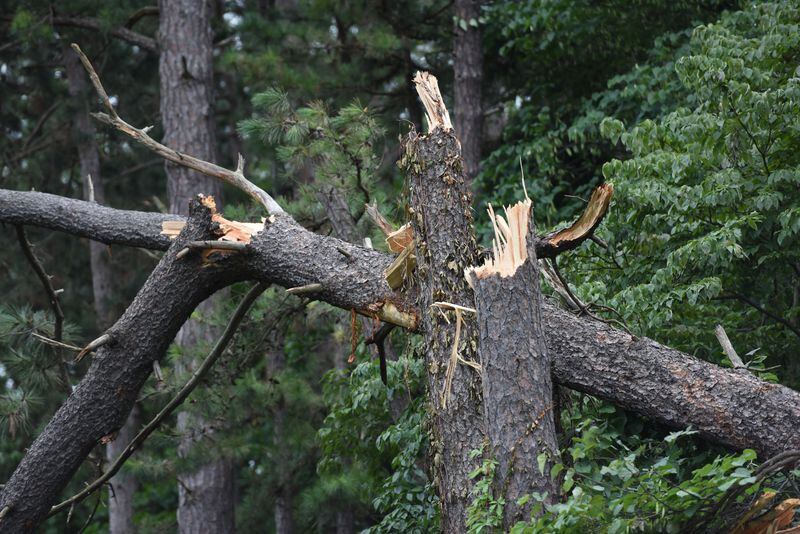City officials are taking swift action to save Northern red oaks in Bird Hills Nature Area after discovering many have Oak Wilt, an infectious and potentially lethal disease that spreads quickly.
Planting native tree species in our community is key to building resilience against climate change and the many invasive pests that have degraded urban forests.
American Beech
American beech trees feature smooth silvery-gray bark that highlights its gentle yellows and tans in autumn foliage, which turns a golden bronze hue in late September or October before eventually falling off with snowfall in winter.
Beech trees are slow-growing trees that tend to reach 40 to 50 feet tall and wide in their native environments (38). Commonly found in groves covering lawns, golf courses, acreages or park-like settings – often in their canopy form extending across multiple acres – beechs make an excellent shade tree species that makes an impactful statement about our environment and community.
Beech leaf disease, caused by the micro-nematode Litylenchus crenatae, can cause severe distortion to leaves and loss of growth. Signs of the disease include dark-brown stripes between leaf veins as well as puckering or bulging in between them; beech leaves are especially prone to fungal attacks on damp sites.
Black Oak
Black Oak (Quercus velutina) is an iconic medium to large deciduous oak species found throughout eastern United States, known for producing food-rich acorns that attract wildlife2,4. Additionally, its wood has many uses as landscaping material and industrial timber species while offering shelter to many animals such as wild turkeys, deer, squirrels, raccoons and chipmunks. You can learn more here: annarbormitreeservice.com
Black oak leaves are simple, 5-9 inches in length, and feature lobes with bristle-tipped lobes at their tips1. Its bark is dark brown or nearly black with scale-covered ridges; while it can withstand low-severity surface fire, basal wounding and crown fire damage are more likely.
Black oak trees thrive across an extensive range of soil conditions from southern Maine west to New York and south to extreme southern Ontario, Minnesota, Iowa and Texas1.1 Some northern trees known as black oak may feature larger buds with less-angled and denser hairiness as well as tighter fitting acorn cups; these could represent geographical variants or hybrids between black and red oak varieties.
Hickory
Shagbark Hickory trees feature peeling bark that reveals layers of white, green, and tan patches, making for an eye-catching landscape tree with dark-green summer leaves and striking yellow to orange-red fall colors. Plus, its abundance of nuts are loved by wildlife!
As with beech trees, American hazelnut trees thrive best in damp forest sites but can tolerate dryer conditions as well. Their distinctive zig-zag branches and glossy thorns add ornamental value to landscapes while providing important habitat for birds and other forms of wildlife.
Oak-hickory forests are prevalent throughout Michigan and due to its wide environmental tolerances can coexist peacefully with many non-oak species. Unfortunately, however, such forests can also be threatened by an invasive, pathogenic, heart rot fungus, which affects some oak species more severely than others.
Pawpaw
Pawpaw (Asimina triloba) is an exquisite native American tropical fruit tree with distinctive custard texture and flavors resembling those found in mango, banana, pineapple and orange fruits. Native to wide swaths of the United States and popular with foragers alike.
Pawpaw fruit can be easily identified by its bright yellow to light green hue, thick custard-like flesh and large seeds. Fully ripened pawpaws only last several days both on their tree and when stored in the refrigerator; making this fruit an unsuitable crop for commercial harvest.
Vegetative propagation may be accomplished through either grafting or budding, with fruit quality differing significantly depending on which seed parent was planted. Because of their propensity for leaf and fruit rot, grafted trees offer the best solution for commercial production. Deer tend to steer clear of them.
Red Maple
This majestic tree is often the center of attention in any landscape. It thrives in wet or moist acidic soils of shrublands and forests, and features dark green summer foliage which turns yellow, orange or red in fall – providing sustenance for white-tailed deer as well as contributing significantly to maple syrup production.
Red maples stand out in any landscape thanks to their thin, light gray bark. Their leaves are small with toothed margins that form “v”-shaped lobes for easy identification.
As with other maples, red maple flowers are polygamomonoecious; however, they can also be dioecious with male and female blooms separated by branches. Red maple trees rank highly in shade tolerance.
